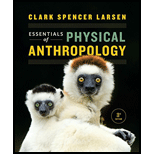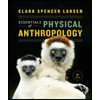
To determine: The examples for life in the trees of primate adaptations.
Introduction:
Primates
Based on tendencies of adaptation, behavior, and evolution, the primates are defined and classified. Primates are found to be the most intelligent and developed group of mammals. They include apes, monkeys, and human beings.
Explanation of Solution
The adaptation of primates on trees is called as arboreal adaptation. This adaptation is found to be unique among the mammals. The primates exhibit the characteristics of anatomy. They possess a unique set of behavior that keeps them differentiated from others.
The two examples for life in the trees of primate adaptations include family of monkeys (apes and baboons) and squirrels.
Primates adapt themselves on trees due to their characteristics of being flexible, mobile, and they possess a versatile skeletal structure. They eat a variety of food due to the different types of teeth in their upper and lower jaws.
To determine: The examples of primate adaptations based on their eating habits (wide range).
Introduction:
Primates
Based on tendencies of adaptation, behavior, and evolution, the primates are defined and classified. Primates are found to be the most intelligent and developed group of mammals. They include apes, monkeys, and human beings.
Explanation of Solution
From the eating habits of primates, they are found to express dietary plasticity. Dietary plasticity refers to the mammals eating a wide range of foods.
The two examples of primate adaptations based on wide range of eating habits include orangutan and chimpanzee.
Primates adapt themselves on trees due to their characteristics of being flexible, mobile, and they possess a versatile skeletal structure. They eat a variety of food due to the different types of teeth in their upper and lower jaws.
Want to see more full solutions like this?
Chapter 6 Solutions
Essentials of Physical Anthropology (Third Edition)
 Essentials of Physical Anthropology (Third Editio...AnthropologyISBN:9780393938661Author:Clark Spencer LarsenPublisher:W. W. Norton & Company
Essentials of Physical Anthropology (Third Editio...AnthropologyISBN:9780393938661Author:Clark Spencer LarsenPublisher:W. W. Norton & Company
